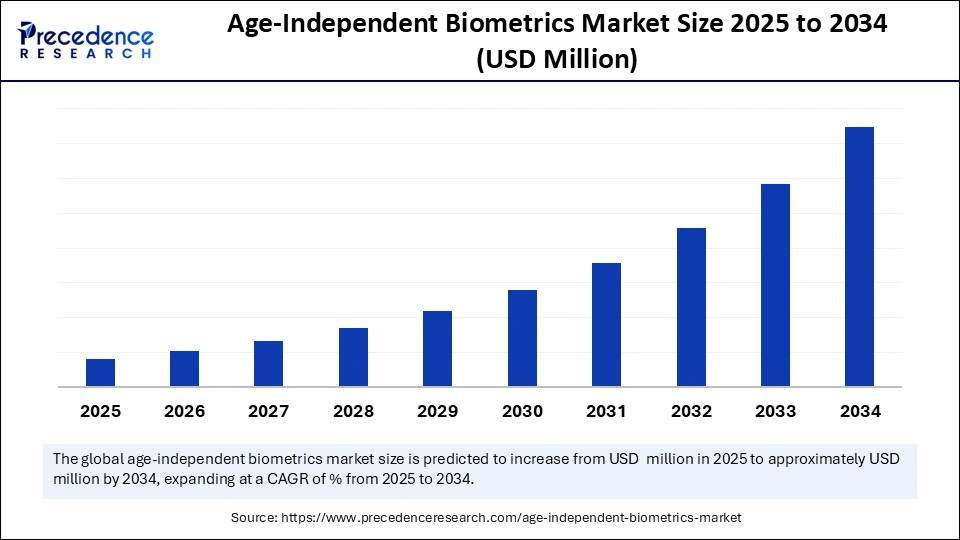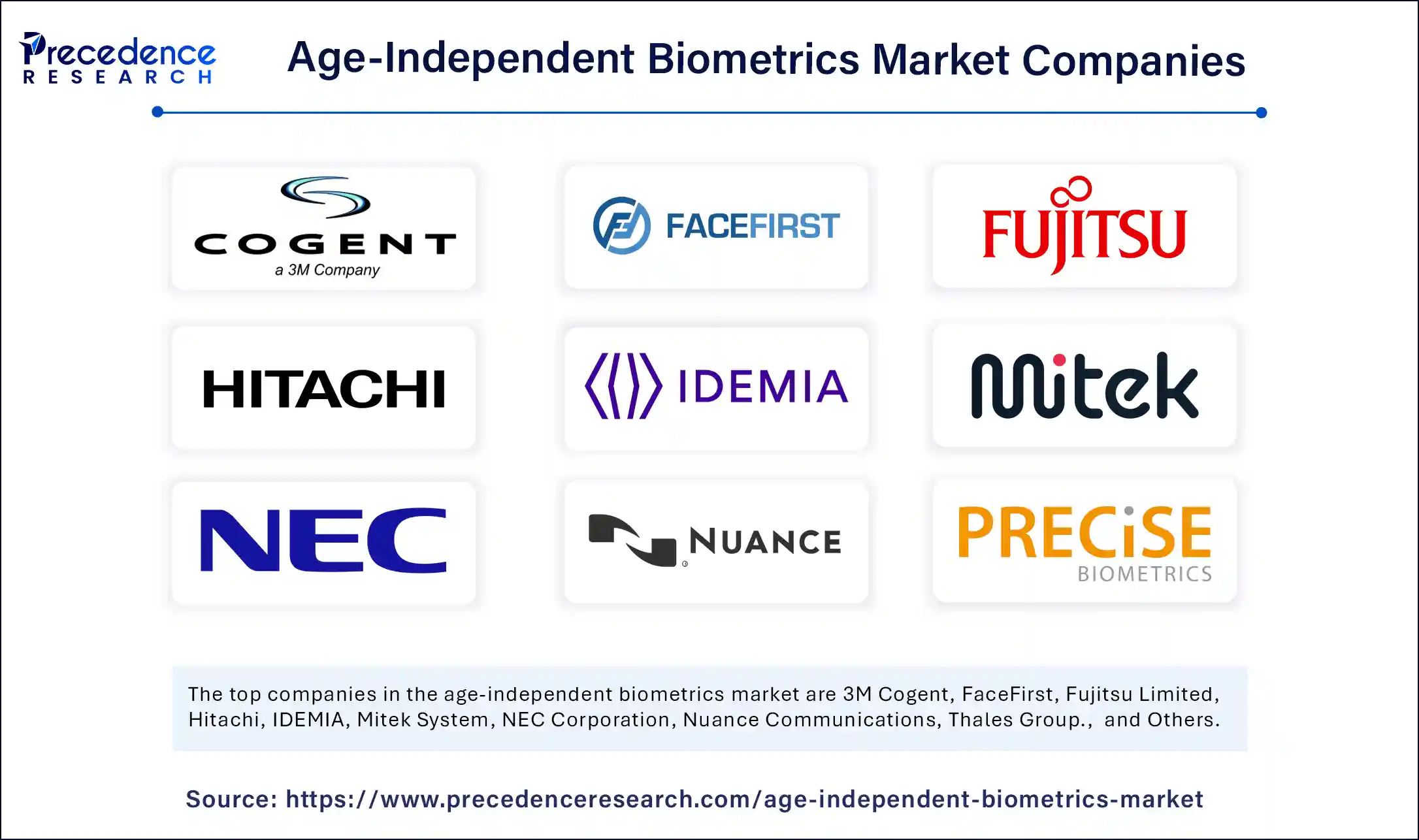List of Contents
Age-Independent Biometrics Market Size and Forecast 2025 to 2034
Age-independent biometrics market is driven by demand for inclusive, age-neutral biometric systems in healthcare, security, and digital identity. The growth of the age-independent biometrics market is driven by rising demand for secure authentication, growing concern over identity theft, and advancements in technology.

Age-Independent Biometrics Market Key Takeaways
- North America led the age-independent biometrics market with the highest share in 2024.
- Asia Pacific is estimated to expand at the fastest rate in the market between 2025 and 2034.
How AI is Making Biometrics Truly Age-Independent?
Artificial Intelligence (AI) is changing age-dependent biometrics by making biometric recognition more intelligent and effective for all ages. Traditional biometric identification systems struggle with age-related physiological changes over time like facial recognition and voice authentication systems. AI can eliminate these challenges with deep learning algorithms designed to recognize differences in biometric traits depending on age. AI systems will continue to evolve by continuously learning how we change with age, minimizing misidentification for authenticating individuals from childhood to old age.
AI is enabling multimodal biometrics, additional biometric modalities that combine overall identity features like facial, iris, voice, and behavior by adding physiologically based biometric modalities in ways that are flexible and user-friendly. As a result, AI systems are providing biometric systems with increased inclusivity, resilience, and adaptability for long-term identification and permitting users real-life scenarios. In addition, AI enables biometric systems to adapt to changes in an individual's biometric traits over time, such as facial changes due to aging.
- In January 2025, Entrust launched an AI-powered identity verification as a new tool for its Identity-as-a-Service (IDaaS) platform, enabling facial biometric authentication by verifying users against their encrypted identity.
(Source: https://www.entrust.com)
Market Overview
The age-independent biometrics market revolves around the production and distribution of biometric technologies that are resistant to age-related performance issues. While many biometric systems face accuracy concerns because a person ages and their facial features or fingerprints change, age-independent biometrics would take their place with stable modalities such as iris recognition, vein pattern, and behavioral biometrics. This technology is particularly useful in areas like healthcare, border security, and financial services, where verifying identity across the entire age continuum from children to senior citizens is essential. The market for age-independent biometrics is witnessing significant growth due to the rising desire for long-lasting, non-reversible, and inclusive biometric systems. The rising demand for multimodal biometrics that offer higher degrees of accuracy and adaptability further supports market growth.
Age-Independent Biometrics MarketGrowth Factors
- Improvements in AI and Deep Learning: Better AI algorithms are improving age-independent biometric recognition, allowing systems to be more reliable and accessible across a variety of ages.
- Adoption in Healthcare: Healthcare and medical systems are using age-independent biometrics for patient authentication to protect patient data privacy while reducing medical and potential legal harm to elderly and pediatric patients.
- Increased Security Threats from Digital Services: Digital security trepidation is increasing on individual and corporate bases, resulting in increased demands for better, age-neutral biometric systems in banking, e-commerce, and government services to enable access across the board.
- Growth of Smart Devices Capable of Biometrics: Smartphones and wearers are becoming commonplace in the modern era and allows for age-independent seamless identification for everyday transactions and online activities.
Market Scope
| Report Coverage | Details |
| Dominating Region | North America |
| Fastest Growing Region | Asia Pacific |
| Base Year | 2024 |
| Forecast Period | 2025 to 2034 |
| Segments Covered | Region |
| Regions Covered | North America, Europe, Asia-Pacific, Latin America, and Middle East & Africa |
Market Dynamics
Drivers
Surge in Demand for Contactless and Secure Verification
The growing need for fast and secure identity verification systems is a key driver of the age-independent biometrics market. The adoption of biometric verification systems/solutions has accelerated the post-pandemic as organizations and governments were increasingly relying on touchless biometric solutions for hygiene and security. For example, the Aadhaar program in India, which is one of the largest biometric systems in the world, has enrolled over 1.3 billion individuals using fingerprinting and iris scanning biometrics, demonstrating the growing dependencies on these technologies in both the public and private sectors.
The financial sector is also implementing facial recognition and behavioral biometrics as a means to avert digital fraud. The airports globally and border control agencies are likely to have biometric e-gates and automated systems (including the U.S. CBP's Biometric Entry-Exit Program) in order to manage passenger flow while augmenting security. With the rapid digital shift post-pandemic caused by an increase in remote work and online services, biometric solutions are quickly becoming a valid form of trust and identity assurance. The growing concerns about fraud and identity theft boost the demand for secure authentication methods, fueling the growth of the market.
Restraint
Data Privacy & Security Issues and Technological Limitations
Growing concerns over biometric data privacy are a substantial factor that limits the growth of the age-independent biometrics market. Because biometric identifiers are stable, illegal use or theft could have implications that are permanent. In 2023, MOVEit software triggered the wave of cyberattack, which affected over 2,700 organizations and exposed the personal data of approximately 93.3 million individuals, serving as another reminder that centralized biometric databases might be a key target for attackers.
In addition to concerns over centralized biometric databases, there are regulatory uncertainties regarding how biometric data is collected, stored, and shared. This creates uncertainty among end-users and organizations, impacting adoption rates. The lack of standard global privacy frameworks makes it even trickier for multinational companies dealing with cross-border biometrics to deploy solutions. Moreover, some biometric systems may struggle with accuracy in certain conditions, like poor lighting for facial recognition, which limits their effectiveness and adoption.
Opportunity
Is Age-Independent Biometrics the Next Frontier in Secure Identity Verification?
The age-independent biometrics is expected to evolve rapidly, spurred by the demand for an inclusive, consistently reliable, and user-friendly approach to identity authentication. Age-dependent biometric systems may suffer reliability shortcomings based on changes undergone with age. Age-neutral biometrics, such as vein pattern recognition and behavioral biometrics, can achieve a consistent accuracy of verification across every age group. A notable advancement is in Apple's use of Face ID, which is better at determining face biometric differences over time, thus improving usability for older and younger users.
A Mastercard pilot of an age-independent fingerprint biometric payment card trial also supports the wider trend in the market toward the development of inclusive security technologies. As digital identity becomes invaluable in sectors like banking, healthcare, and e-governance, age-neutral biometrics is becoming a unique opportunity. An age-independent biometric technology is now the basis for the next wave of identity management systems.
Regional Analysis
Why is North America Leading the Age-Independent Biometrics Market?
North America registered dominance in the market by capturing the largest share in 2024. The region is an early adopter of advanced security solutions, including biometrics. The increased dependency of North American businesses on identity management systems created the need for age-independent biometrics. North America has also been leading in the implementation of biometric technologies as part of border control and airport security systems to enhance risk profiling, as well as customer service. Besides, regulatory support for identity verification systems bolstered the growth of the market within the region.
The U.S. is a major player in the market. The primary reasons for sustaining the country's position in the market are ongoing investment in AI-based biometric solutions and a strong focus on cyber and physical security. The U.S. Department of Homeland Security (DHS) and other federal agencies have embraced age detection software as part of public safety infrastructure. The U.S. is home to leading software development companies, driving innovations and development of biometric solutions.
Why is Asia Pacific Exhibiting Rapid Growth in the Age-Independent Biometrics Market?
Asia Pacific is expected to witness rapid growth in the coming years, driven by rising security needs in both public and private sectors. As governments and businesses try to combat fraud and identity theft, advancements in biometric systems are enabling them to more accurately identify users by adding age-differentiating features into biometrics. Additionally, the rise of smart healthcare and mobile banking has created the need for secure authentication systems.
China is leading the charge by rapidly deploying biometrics for surveillance and biometric authentication for commercial activities that utilize age estimation algorithms. The national and local governments in China are all utilizing facial recognition for law enforcement and critical public services in various forms, which is mirrored by innovations from private sector firms investing in payment systems that are beginning to utilize age-based access controls based on content and service restrictions. China's major tech companies are also investing heavily in improving AI to increase biometric reliability since consumers come from a range of ages, further allowing inclusivity and security.
Age-Independent Biometrics Market Companies

- 3M Cogent
- FaceFirst
- Fujitsu Limited
- Hitachi
- IDEMIA
- Mitek System
- NEC Corporation
- Nuance Communications
- Precise Biometrics AB
- Suprema HQ
- Thales Group.
Recent Developments
- In March 2025, Outseer, a recognized leader in authentication and fraud prevention for digital banking and 3-D Secure (3DS) transactions, announced its platform-native Behavioral Biometrics capability. The addition of platformized Behavioral Biometrics introduces another layer of defense that continuously analyzes user interactions to detect anomalies in real time. Building on its rich RSA heritage, Outseer has enhanced its platform to meet dynamic threat landscape.
(Source: https://www.businesswire.com) - In May 2025, Worldcoin introduced a new portable biometric device named Orb Mini, designed to streamline the iris scanning process for easier identity verification. The portable biometric device is designed to simplify human verification using iris-scanning technology.
(Source: https://mobileidworld.com)
Segments Covered in the Report
By Region
- North America
- Europe
- Asia-Pacific
- Latin America
- Middle East and Africa
For inquiries regarding discounts, bulk purchases, or customization requests, please contact us at sales@precedenceresearch.com
Frequently Asked Questions
Ask For Sample
No cookie-cutter, only authentic analysis – take the 1st step to become a Precedence Research client